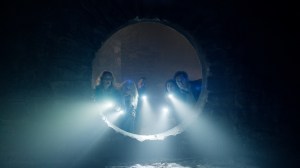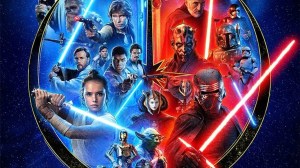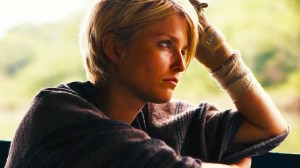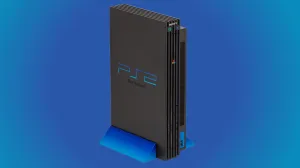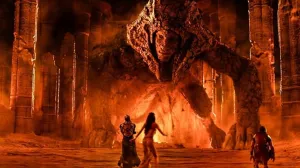WandaVision was the Marvel Cinematic Universe’s first television series to come to Disney+ and featured nine mind-blowing episodes that resulted in Wanda Maximoff (Elizabeth Olsen) finally becoming the Scarlet Witch. The series includes a lot of impressive VFX work, some of which was done by Digital Domain. In honor of the show coming to an end, ComicBook.com recently had the chance to chat with Digital Domain’s Marion Spates.
Videos by ComicBook.com
During our interview, Spates went on to detail the effects used in many important WandaVision moments. Spates talked about working on White Vision, Scarlet Witch’s final costume, Chaos Magic, the Hex, and more. You can check out our full interview below…
MARION SPATES AND VFX HISTORY
ComicBook.com: Could you tell us a little bit about your role at Digital Domain?
Marion Spates: I’m Marion Spates, VFX supervisor at Digital Domain. I’ve been here for about 16 months. I’ve been on the client-side for probably about the last eight years on and off on various films. A little bit of backstory, I was born in Louisiana, grew up in Texas, and moved to Los Angeles in 2001 to work in visual effects. I’ve been here ever since.
CB: One of the first movies you worked on as a digital artist was Harry Potter and the Chamber of Secrets, which is about to turn 20. What do you think is the most drastic difference in effects versus 20 years ago?
MS: I would have to say the scope of what we’re all being asked to do. I mean, the technology. Our technology grows every year, every six months, and one of the most complicated things to do is to stay up with the technology. So as the producers and the showrunners see the technology evolving, look at virtual production as one of them, we just get asked to do things that are harder and harder, and harder. And we keep pulling it off, right? That’s really the drastic thing.
Back in the day, if we’re doing a character, the methodology that we used to create that character. Now, today, how those characters even have more detail, we can render them at higher quality. We have better machines, more RAM. That’s really the difference is us just having more tools and more computer speed, really to just keep punching the bar higher.
WHITE VISION
CB: Digital Domain worked a lot on White Vision, which I imagine presents a unique set of challenges. Even just the coloring, is that more difficult?
MS: It’s always really difficult to put a white character in a low-lit or even a very hard sunlit environment, so we had to very strategically dial in his white. I mean, obviously, we would just lean into his white, because his costume is white. As we’re dialing in capes and heads, we would lean into what he looked like with his actual outfit. We had this really cool effect … Do a very thin film interference layer to his face. When you look at a bubble at a certain angle, how you have that rainbow effect, so we introduced that and you would primarily see it in his specularity as his head would move. We leaned into that a lot, which helped. It’s not super present. It’s just there. And it also gives a little bit of color variation to the whiteness of his costume, which was really nice.
CB: Were there any additional obstacles considering there were two Visions? Was there anything you had to be extra mindful of knowing that there was a second Vision around?
MS: Well, I mean typically when there’s a second Vision around, you’re going to have to replace one of them. Because obviously Paul [Bettany] would play White Vision, and then he would also play Red Vision. So his accompanying Vision would be a stunty, right? So the challenging part there was to just make sure we could put Paul as Red or as White, right? With the accompanying Vision. So that was mostly the challenging part just to make sure they were a mirror-like image.
CB: How much was Paul Bettany involved in that process? He gets his face scanned? How does that work?
MS: As far as the development of both, Marvel has come up with the concept for the White Vision and the Red Vision … White Vision obviously being a new character, so we knew we would take Red Vision and transform into a light Vision. We just started with red and developed that into white. We started with concept artwork that we received from Marvel. Marvel actually created his whole costume. They did a really nice job on that. One thing we did find out as we were diving into the plates and things, we started to augment the color of his white a little bit. There were a little bit more off colors. So we did a little bit of augmenting to the actual suit of himself.
With White Vision, we scanned him. On set, we would just completely scan so we have the full body, so then we bring the body back. While we’re there, we shot high-resolution photography of the suit with Paul in the suit. We also did some details with the stunt double as well, so that way we wouldn’t take up too much of Paul’s time. With the head, it was a little bit trickier, because we don’t have a head on set that we can stand or photograph. So we then took that head, the concept head that Marvel has come up with. We start with the Red Vision’s head, we take it into ZBrush, and then what we do is we sculpt really quickly what this new White Vision head could look like by taking a Red Vision and putting in the details of the White Vision.
White Vision, you had much more angular edges to him, right? Because he’s more stoic. His character himself was much more stoic. Paul, even when he would act as White Vision, he did an amazing job. The stoicism of him. He was even a slightly different character on set because he leans into the character that he’s being at the moment. It was really a stunning experience to actually see the way that he was able to turn the switch on from a Red Vision to White Vision. That was inspirational to all of the team.
CB: I read that there’s a new muscle transfer tool. What exactly does that mean? What would have been done in the past?
MS: That tool was really used to basically take the innards. We had to create the innards of White Vision for the face effect. So on the inside, when Vision faces, in the past, you always saw a little bit of that circuitry type of texture within his body. So what we did was, we tried to lean into a little bit more of that texture detail. To make the detail feel like it’s part of his body, we took our muscular system, and that muscular system was used to help model the formation of the tech that would be within his body.
Once that tech is within his body, we could then transport, transfer that information over to a Red Vision, much simpler than having to go in and manually remodel, reaugment. It just gives us the ability to form the innards of his body via the muscular system to his body.
In the past, we go in, we model things. They would have to try to model individually the muscular system. But we took this muscular detail from this software, then we could use that to quickly augment the shape of the innards within his body.
SCARLET WITCH’S COSTUME
CB: In addition to White Vision, there was also work done on the Scarlet Witch suit. How much of that outfit was done digitally?
MS: Basically they built the entire outfit, right? They even built her cape, they built everything for Scarlet Witch’s outfit. One thing as we quickly started filming, I was on set for the entire time. Elizabeth couldn’t get in a wire, couldn’t be hanging on wires with the cape on, because the cape was just so bulky and it was just getting pulled in all these odd ways. So the one thing we had to quickly do on set was to start stripping her down and removing the cape. So we removed the cape, there’s a hood, obviously, that’s part of the cape as well. So we took that off. We filmed her.
What we did afterward was put the cape, put the hood on, and that was all done with the CFX because it’s all cloth and flowing. There was a little part too, a little leather, like these little straps in the front. I don’t want to misrepresent the name of them, I’m not a costume designer, but there was another element in the front kind of like a belt. I’ll call it, for simplicity’s sake, a belt that we needed to remove because it was hard for her to maneuver and it was getting in the way of the wires. So obviously, one of our jobs as a VFX department is to help Elizabeth be comfortable. We would remove the things that were making her uncomfortable, so she can actually act out the tasks easier, and then we start putting that back in digitally.
WANDA AND AGATHA’S MAGIC
CB: For the Wanda and Agatha fight, was Digital Domain mainly on the Wanda side? Did you work on Agatha’s magic, too?
MS: Oh, yeah. We did both. We helped conceptualize both Wanda’s magic and Agatha’s magic. It’s interesting, in the very beginning, the thought was it was going to be her red magic, right? But just purple. But then early on, in a few of the other episodes, I think it was [episode 8] when you really see [Agatha’s] magic whenever she’s stealing the magic from the other witches. They started to come up with the idea for her magic to have a little bit of that black, inky feeling magic. So it was a little bit of purple core with this black inkier element that goes around. It’s not super wispy.
I thought that was a really nice touch that they came up with. Wanda’s magic being the Chaos Magic, there was obviously some specifics that they wanted for that, but Agatha kind of leaned more to this inky, purple-y feel just to give it another flavor of magic. It might’ve been a little bit confusing if we would’ve gone with the Chaos-red version just being purple. So they wanted to distinguish her magic to be something different.
THE HEX
CB: Any cool details from the series that haven’t come up yet?
MS: The Hex wall was a pretty challenging thing to work on. The Hex wall is made up of three elements inspired by the cathode ray tube, a tube TV. The type you see at home, older sitcom reference in the show. The phosphorus pattern was derived from, if you take a magnet and you hold it up to a CRT, you see the whole image conform to the magnet. So that was a huge part of the Hex wall.
The second effect was the catalytic lines, which mimic the lines you see in a CRT T.V. And those would also be the lines that would be glitching as the T.V. is distressed. And the third one was the catalytic panels, which are smaller cubes that made up another level of detail within the Hex wall. The Hex wall was really mimicking a distressed T.V., because of the whole language about WandaVision, it gives me chill bumps, was all about this T.V. and these decades as you go through it, how television progressed. And they lean very much into the design of the Hex wall to be a part of that as it developed across all of the episodes.
WORKING IN THE PANDEMIC
CB: Last summer, I spoke to Mitch Drain about Agents Of SHIELD, and he talked a lot about how the job has been different since working from home in the pandemic. Have things changed in recent months? Are you getting back to the office or is everything still being done from home?
MS: Right now everything is still being done from home. Obviously, we all have different thoughts about whether we want to go back to the office or not. My personal thought is I miss being around people and being able to just go to a conference room and figure things out. But I can say it’s been an inspirational thing for us all to come together and pull it together. What DD has pulled off by giving us all the ability to work from home. It’s literally like being in the office.
We have our workstation here. We have our monitors here. And in a way, I feel like we were maybe even a little faster at communicating. Sometimes it’s a little tricky, you got to go to the meeting room and find someone, and make a time for everybody to get together. But I do feel like there has been a part of this that has made it a little bit easier, as far as just working together, as far as quickly communicating with one another being in multiple facilities.
DIGITAL DOMAIN AND MARVEL
CB: In a series like this that’s so full of effects, how was your piece of the puzzle decided? How was it decided what Digital Domain would work on for WandaVision?
MS: Typically what happens is, they’ll look at the body of work and figure out what vendors do what the best, right? Even from my experience being on the client-side, you lean into what the vendors can do. Digital Domain is great at character work. We did such a really good job with Thanos, right? So I’m sure that Marvel feels comfortable with us in characters. And it was great. They leaned quickly on us to develop the White Vision, which was definitely something amazing to be a part of. I mean, even Agatha and even Scarlet Witch. Obviously knowing that there’s going to be this big fight between witches and then also the Vision. It made the most sense for us to work on that type of work.
CB: What’s it like keeping those Marvel secrets?
MS: Any time you’re asked to pull off the kind of things that we were asked to pull off, especially in this short period of time, and then obviously just knowing Marvel and how ambitious they are, it’s quite hard to keep those secrets. The one thing that makes it easier is we have each other here in the office to work with and develop the ideas or help bring the ideas to the table that Marvel has asked us to achieve.
CB: Digital Domain did some work on Black Widow. Is there anything that you know about that or can tease since the movie is coming out soon?
MS: When I started, obviously that [movie] was in development, and it was still going on during WandaVision. The only thing I can say is, I was lucky enough to have some guys and girls that worked on Black Panther to join my team, which definitely upped the ante for the show, which was great.
CB: Scarlet Witch is coming back in the new Doctor Strange movie. Is that something that you will be working on?
MS: I don’t think I should really say. I mean, there are some things happening in other Marvel shows right now. But I want to be careful what to share, because I don’t know who knows what.
CB: Are there any upcoming projects for Digital Domain or for you personally that you’re excited about?
MS: Unfortunately I don’t think I can really say. I can say that I’m excited about all projects. All of them bring a lot of challenges, and I’m just open to anything that we can assist the filmmakers to make.
…
WandaVision is now streaming on Disney+.

